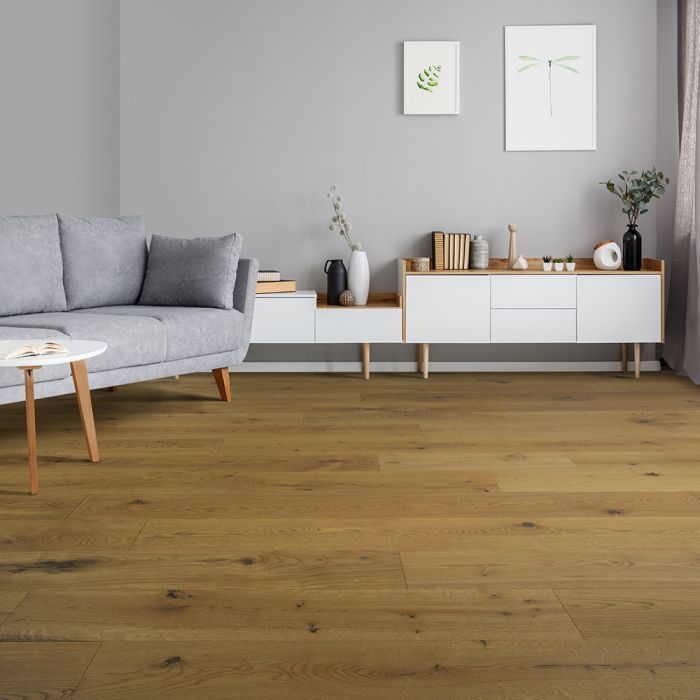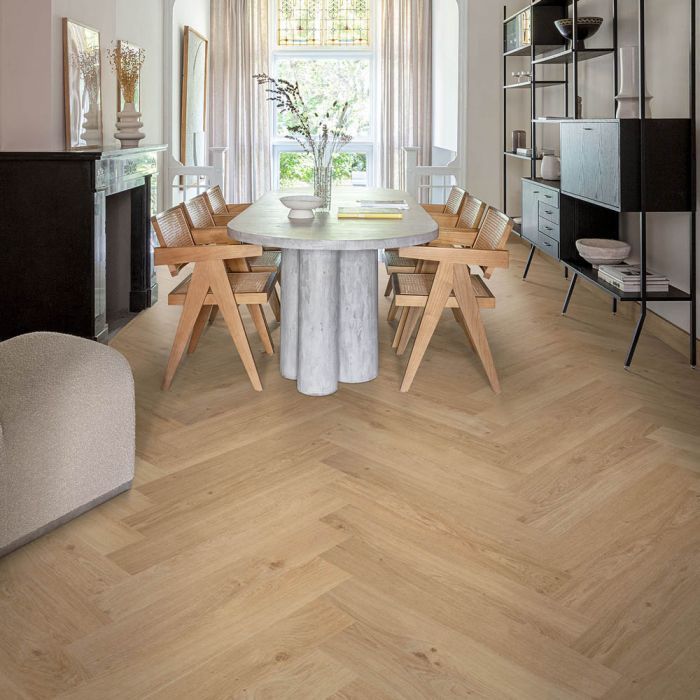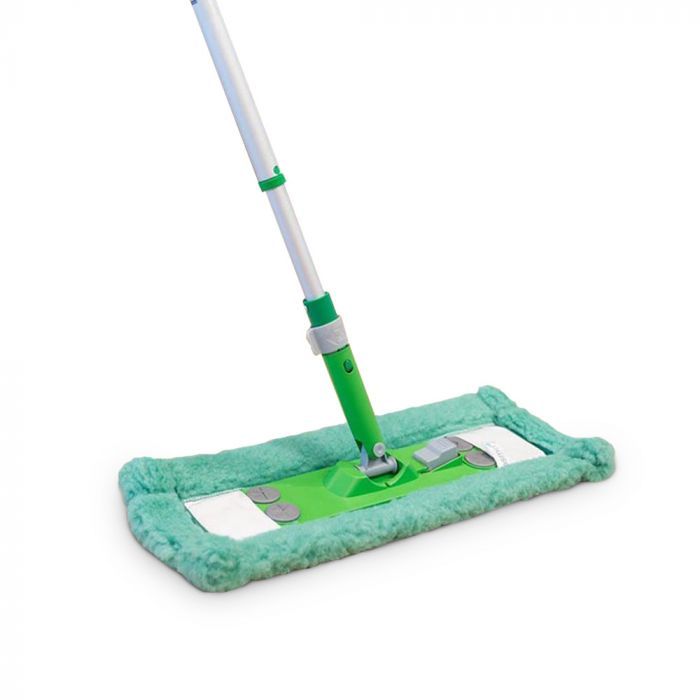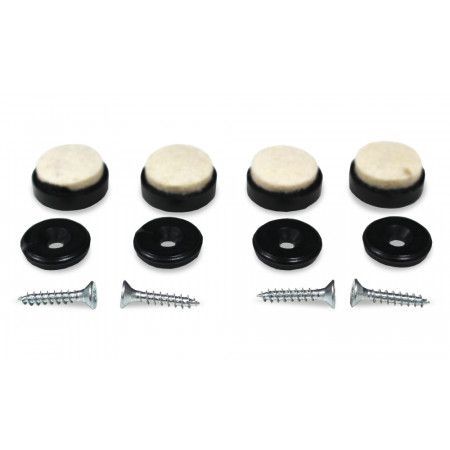You may encounter quite a bit of jargon in the world of hardwood flooring, so we thought we'd put together this Hardwood Flooring Jargon Buster. By the end, you should know what a Flush Reducer is used for, the purpose of a Damp-Proof Membrane (DPM), and quite a bit more...
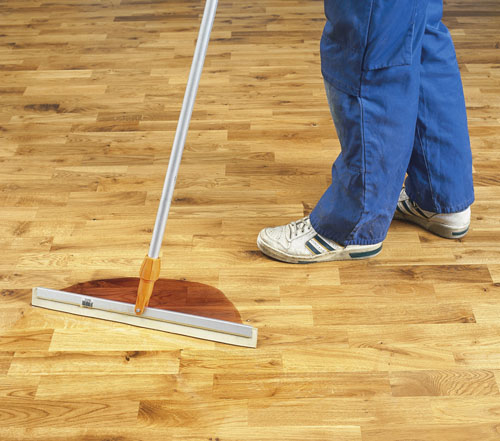
A | B | C | D | E | F | G | H | I | J | K | L | M | N | O | P | Q | R | S | T | U | V | W | X | Y | Z
Acclimatise – To allow the wood flooring to adjust to the temperature and humidity of the property where it is to be installed.
Adhesive – A chemical compound/ glue used to bond the floor covering to the subfloor.
Anti-Slip Flooring – A floor with a particular finish to overcome the problem of people slipping or falling over.
Bamboo Flooring – Eco-friendly flooring made from Bamboo grass rather than hardwood trees.
Beading – A flooring accessory, sometimes known as quarter round, which covers an expansion gap when installing flooring against existing skirting boards.
Cleaning – The removal of unwanted dirt, dust or water from a surface.
Click System – A floor fitting system that allows flooring planks to be clicked and locked together. It is an alternative to the traditional tongue and groove system and is provides of the quickest and easiest ways to fit a floor.
Damp-Proof Membrane (DPM) – A barrier that protects against ground moisture from penetrating the subfloor and/or floor covering.
Durability – The ability for a wood floor to withstand conditions without significant change in its appearance.
End Cap – A flooring accessory for installing against carpet edges or other low lying interior floors.
Engineered wood flooring – Flooring made up by bonding multiple layers of wood together and finished with a solid wood top layer (wear layer) of a chosen species of flooring. The wear layer must be at least 2mm thick otherwise it is classed as veneered flooring. The base layer, which cannot be seen once installed, is usually plywood.
Finger Joint Flooring – Solid pieces of wood joined by cutting rectangular ‘fingers’ on each and gluing together. The joints are almost invisible and give a rustic effect to the flooring. It provides longer and wider flooring planks at a more reasonable cost than solid wood flooring.
Finished Floor – A floor that has been finished with either an oil, lacquer or varnish to protect the surface of the flooring from damage and stains.
Flexible Flooring Adhesive – Glue that bonds the hardwood floor to the subfloor and allows for some natural movement to take place.
Floating Floor – When the flooring sits on top of an underlay without being secured to the subfloor. Only engineered flooring can be ‘floated’. A floating floor is usually necessary with underfloor heating; it allows the floor to expand and contact with the fluctuation in temperature.
Flush Reducer – A flooring accessory that reduces the flooring down to a different level.
Forest Stewardship Council (FSC) – A global organisation dedicated to the responsible management of the world’s forests. FSC ensure that the harvest of timber maintains the forest’s natural biodiversity and ecological processes, whilst adhering to long term forestry management plans.
Grade – A term used to define the quality, appearance and structural properties of the raw timber flooring.
Hardwood – Hardwood is mainly from deciduous trees and broad leaf evergreen trees. The wood is dense and has a more complex structure than softwood, which is the reason they are usually heavier and harder, and ideal for furniture and flooring.
Janka Hardness Scale – A scale used to measure the hardness of a wood species in comparison to another species. It determines whether a species of wood is suitable to use as flooring.
Lacquer – A type of finish that can be added to hardwood flooring. It is smooth to the touch and hard wearing, offering a durable protective layer. Lacquer is usually available in a matt or semi-matt finish.
Laminate flooring – A picture of wooden flooring laminated onto high density fibreboard.
Levelling Compound – A self-levelling product designed for smoothing out or raising subfloors in preparation for wooden floor installation.
Liquid Wax – A combination of wax and solvent that is liquid at room temperature.
Loose laid – When a floor is not fixed directly down to the subfloor. The floor may be ‘floated’ over an underlay. Only engineered flooring can be loose laid and it is usually a method of installation associated with underfloor heating so that the floor can expand and contract with the temperature changes.
Moisture Content (MC) – The amount of moisture or humidity that is present in a subfloor or floor covering. The MC of the subfloor should be checked before installing any hardwood floor. If the MC is too high the hardwood floor may expand and contract, causing irreparable damage.
Moisture Meter – A meter used to check the amount of moisture present in a subfloor.
Oiling – The process of applying oil to the surface of a hardwood floor to change its appearance.
Parquet Block Flooring – A wooden block of flooring with a square edged surface. Parquet blocks come in standard sizes and many different patterns can be created.
Pipe Cover – A flooring accessory that surrounds the base of pipework.
Quarter Round – A flooring accessory, sometimes known as beading, which covers an expansion gap when installing flooring against existing skirting boards.
Ramp – A flooring accessory that reduces the flooring down to a lower level.
Sanding – A process used to remove the top layer of hardwood flooring.
Scotia – A flooring accessory that covers an expansion gap when installing flooring against existing skirting boards.
Screed – A sand and cement mixture used on top of a concrete subfloor to create a smooth, level surface so that flooring can be installed.
Secret Nail – An installation method usually associated with a timber subfloor. A nail is fired at a 45 degree angle into the tongue of a T&G board. The nail is hidden from view and secures the flooring planks to the subfloor.
Secret Screw – An installation method usually associated with a timber subfloor. A screw is angled through the tongue of a T&G plank at 45 degrees, ensuring that it is hidden. This method secures the flooring planks to the subfloor.
Sheen Level – The degree of lustre of the finish of the floor. Hardwood floors are available with a variety of sheen finishes including: matt, gloss, silk matt and satin.
Skirting – A flooring accessory designed to cover a 10mm expansion gap between flooring and wall.
Solid wood flooring – Flooring made from a solid piece of wood. It is available in random lengths and different thicknesses ranging from 15mm to 22mm.
Species – The type of tree that a flooring is made from, e.g. Oak or Walnut.
Staining – The process of applying a wood stain to change the appearance or colour of the hardwood floor.
Stair Nosing – A flooring accessory that covers a 90 degree angle of stair tread.
Subfloor – The existing floor in a property. The most common types of subfloor are: joists, concrete, wooden floor boards, plywood, chipboard, asphalt and bitumen.
T-Moulding – A flooring accessory to cover the join between two floors of the same height.
Threshold – A flooring accessory used when installing wooden floor over carpet edges and perimeter walls.
Tongue and Groove (T&G) – The traditional method of fitting a wooden floor. The flooring planks have one long side and one short side with a machined protruding edge (tongue) and one long side and one short side with a machined rebated edge (groove). The tongue fits into the groove perfectly creating a smooth, gapless flooring surface.
Under Floor Heating (UFH) – A form of central heating installed underneath a floor. UFH is either an electrical system or hydronic system (fluid flowing in pipes) and usually controlled by a thermostat.
Unfinished Floor - An unfinished floor is the raw material. It must be sealed with either a lacquer or oil to provide protection against dirt and water spills.
Underlay – A cushioned middle layer between the subfloor and the hardwood floor that is usually used for thermal resistance and/or sound proofing.
Urea-Formaldehyde – A synthetic resin containing two chemicals: urea and formaldehyde.
Veneered flooring – A high density fibreboard base with a thin (less than 1mm) top layer of real wood, which cannot be sanded.
Wear layer – The solid wood top layer of engineered flooring.
WPVA glue – Water resistant adhesive used to bond the tongue and groove joints of engineered or solid flooring.
For questions relating to any Ambience Hardwood Flooring products, telephone 0116 2741050 or email mail@ambiencehardwoodflooring.com. Thanks for reading.

